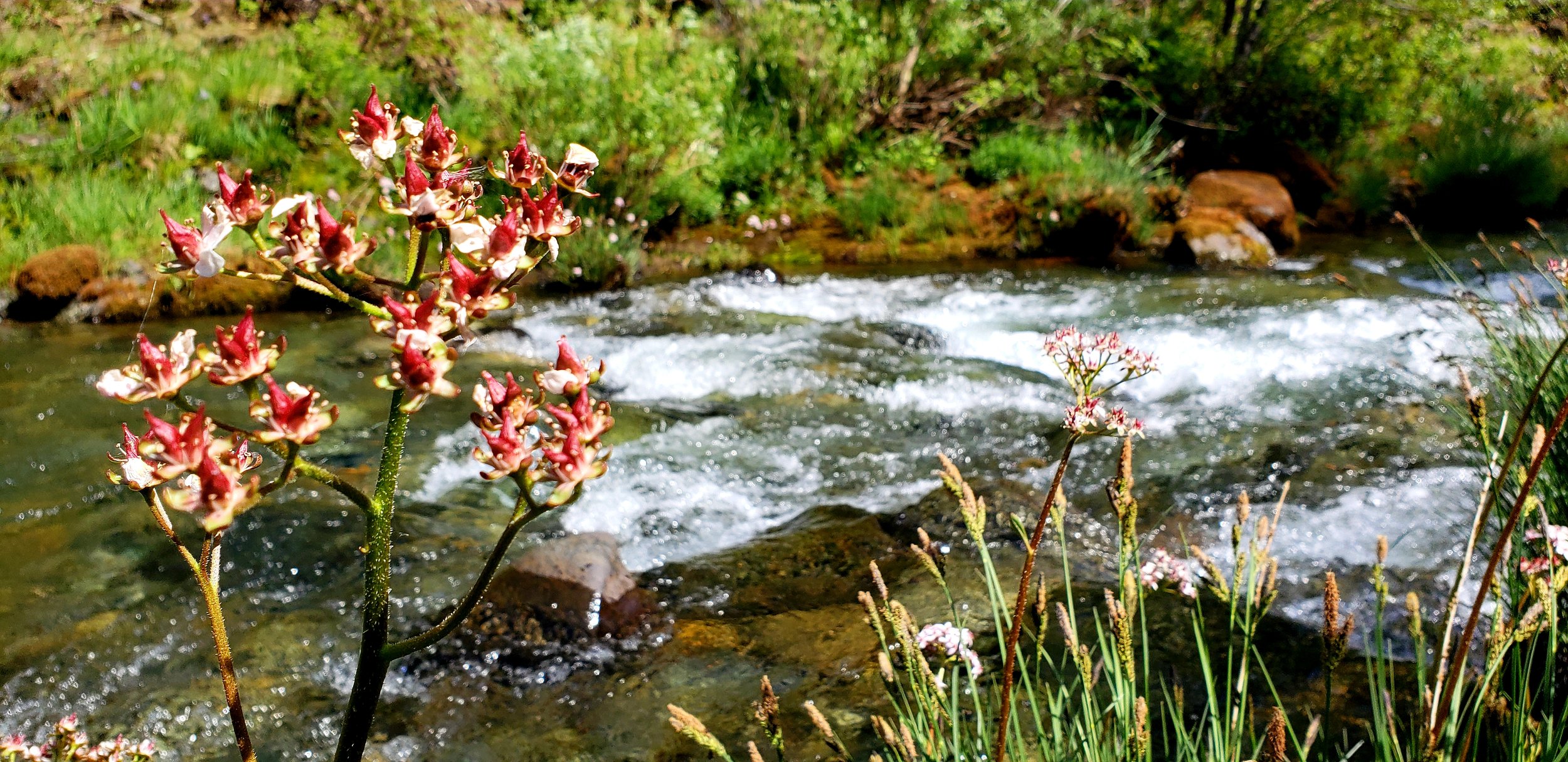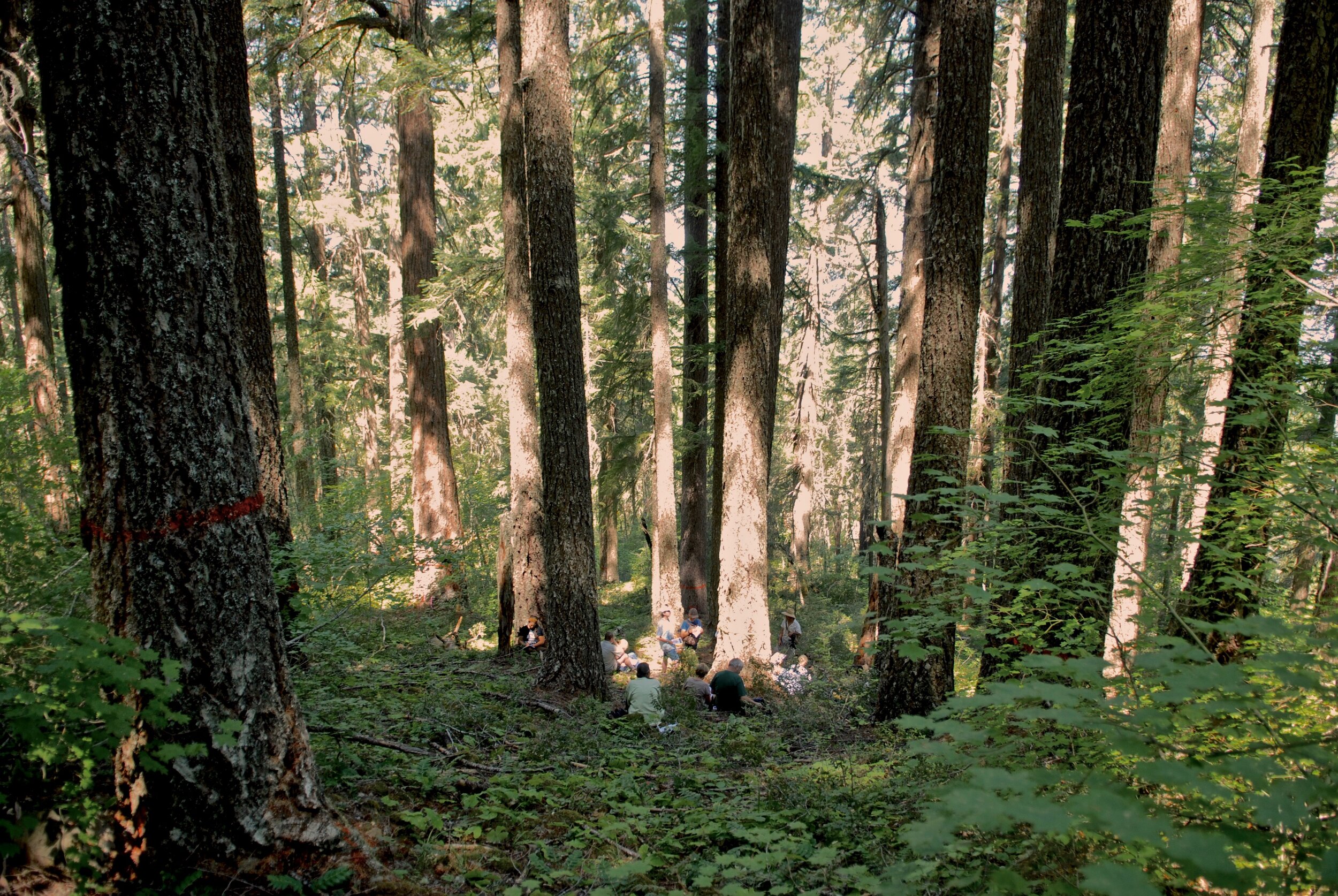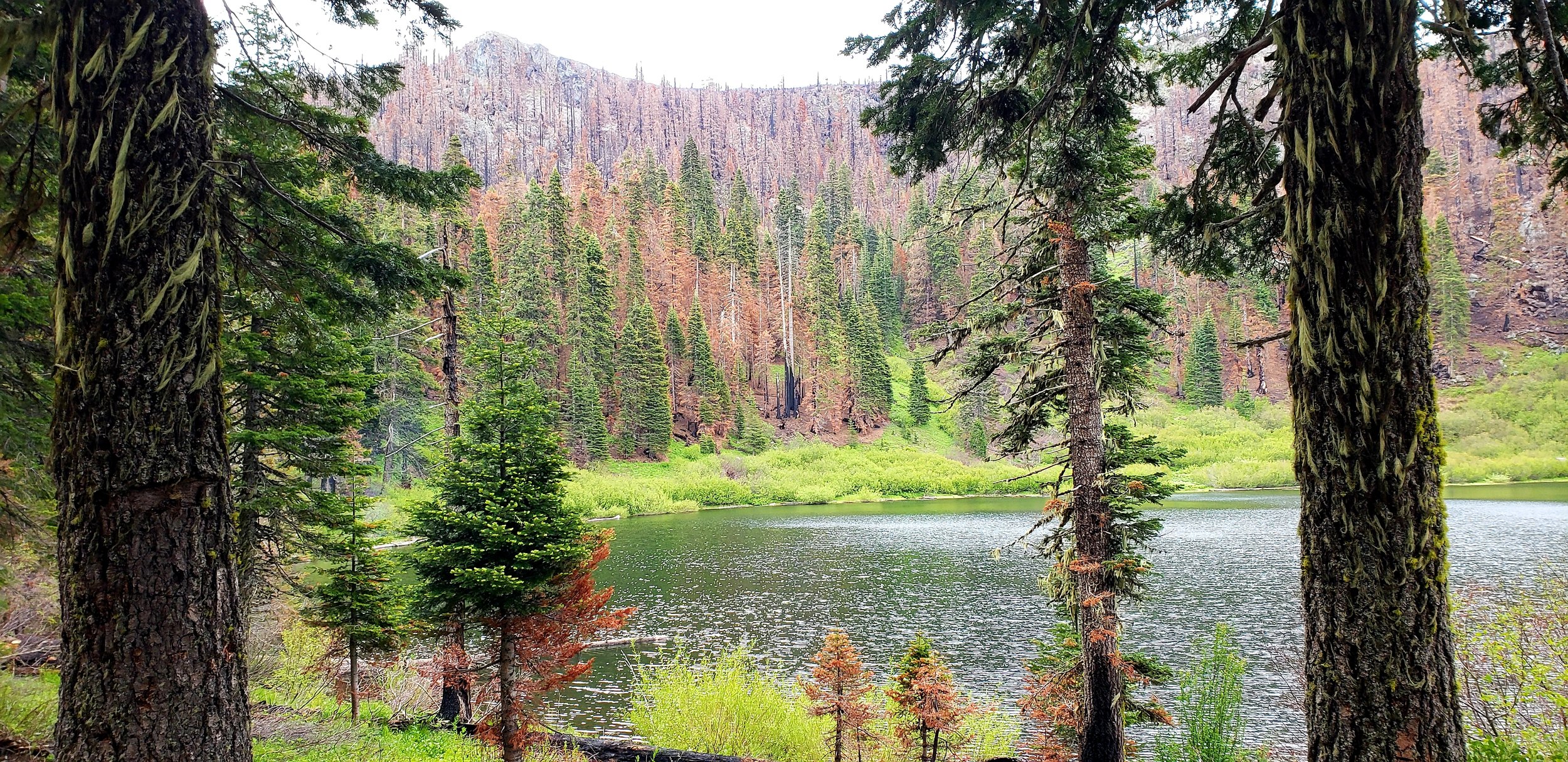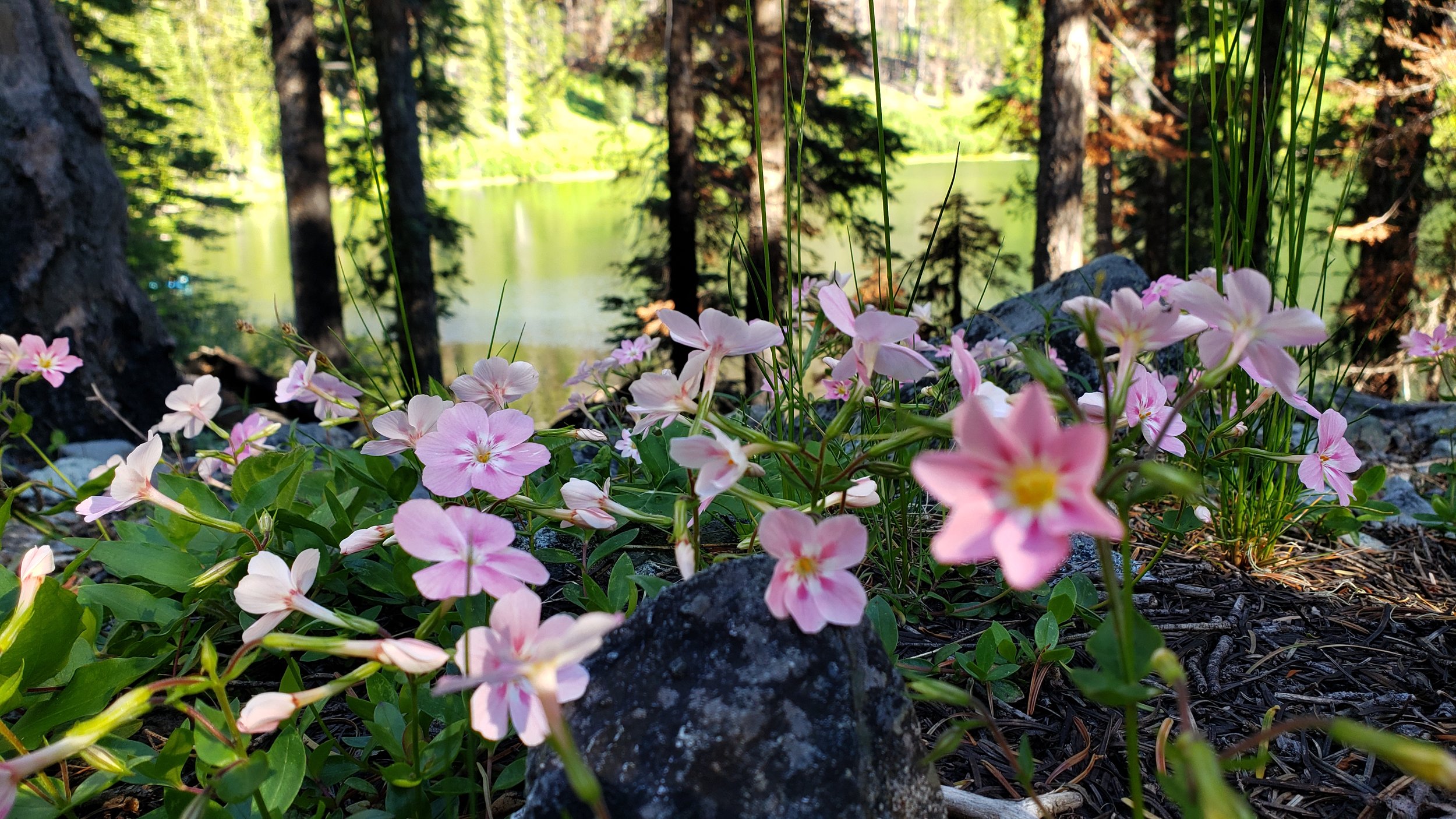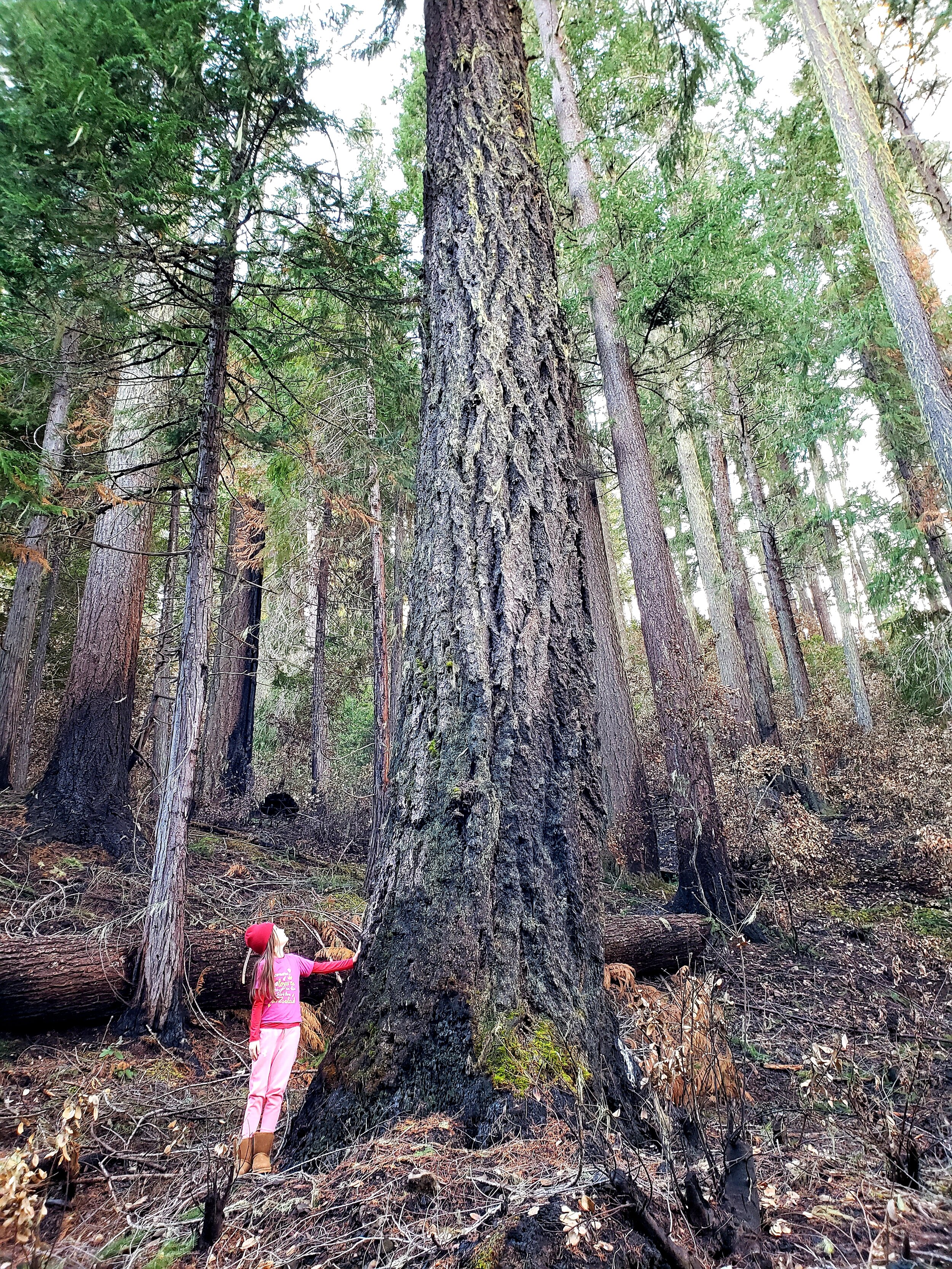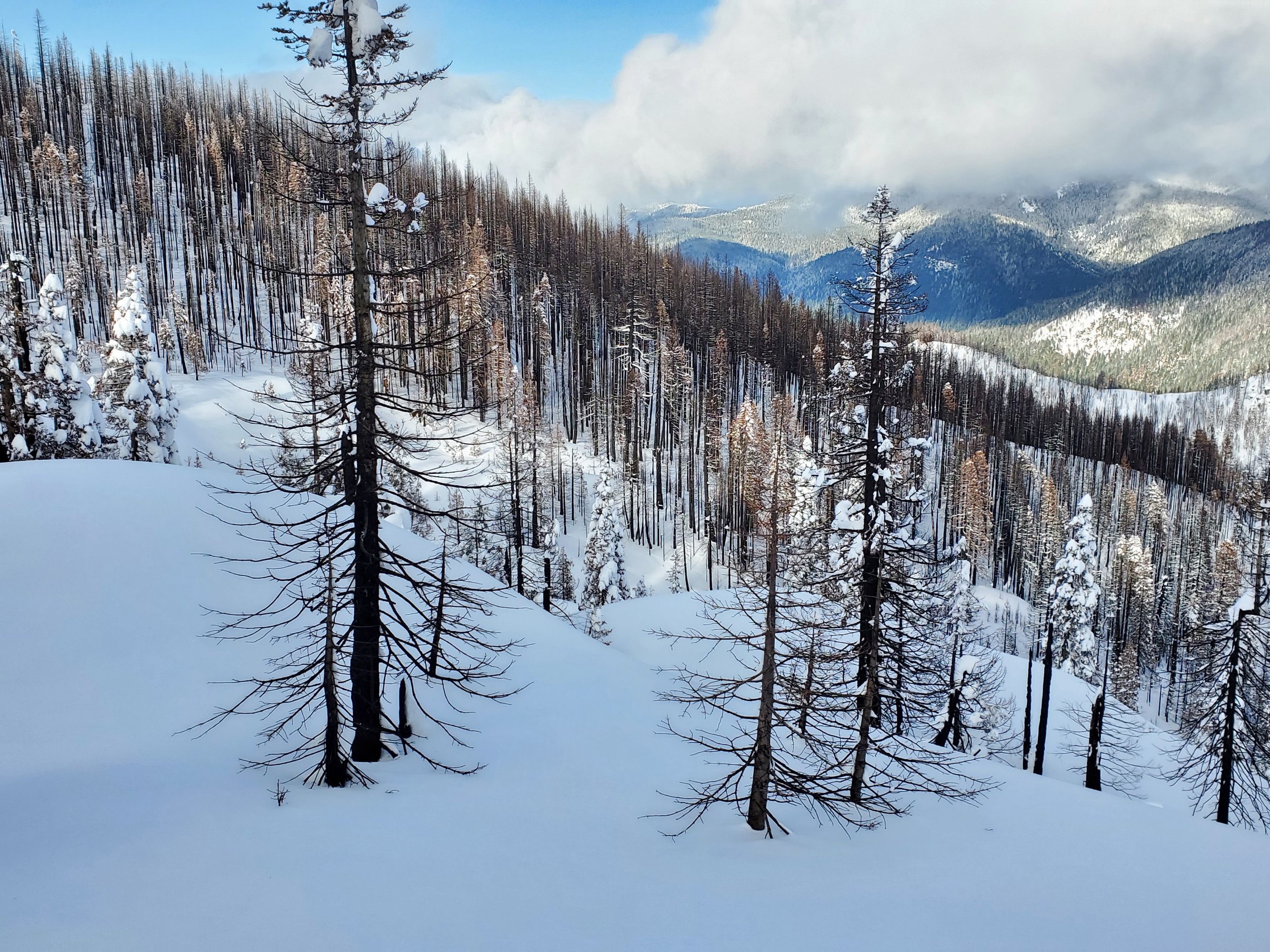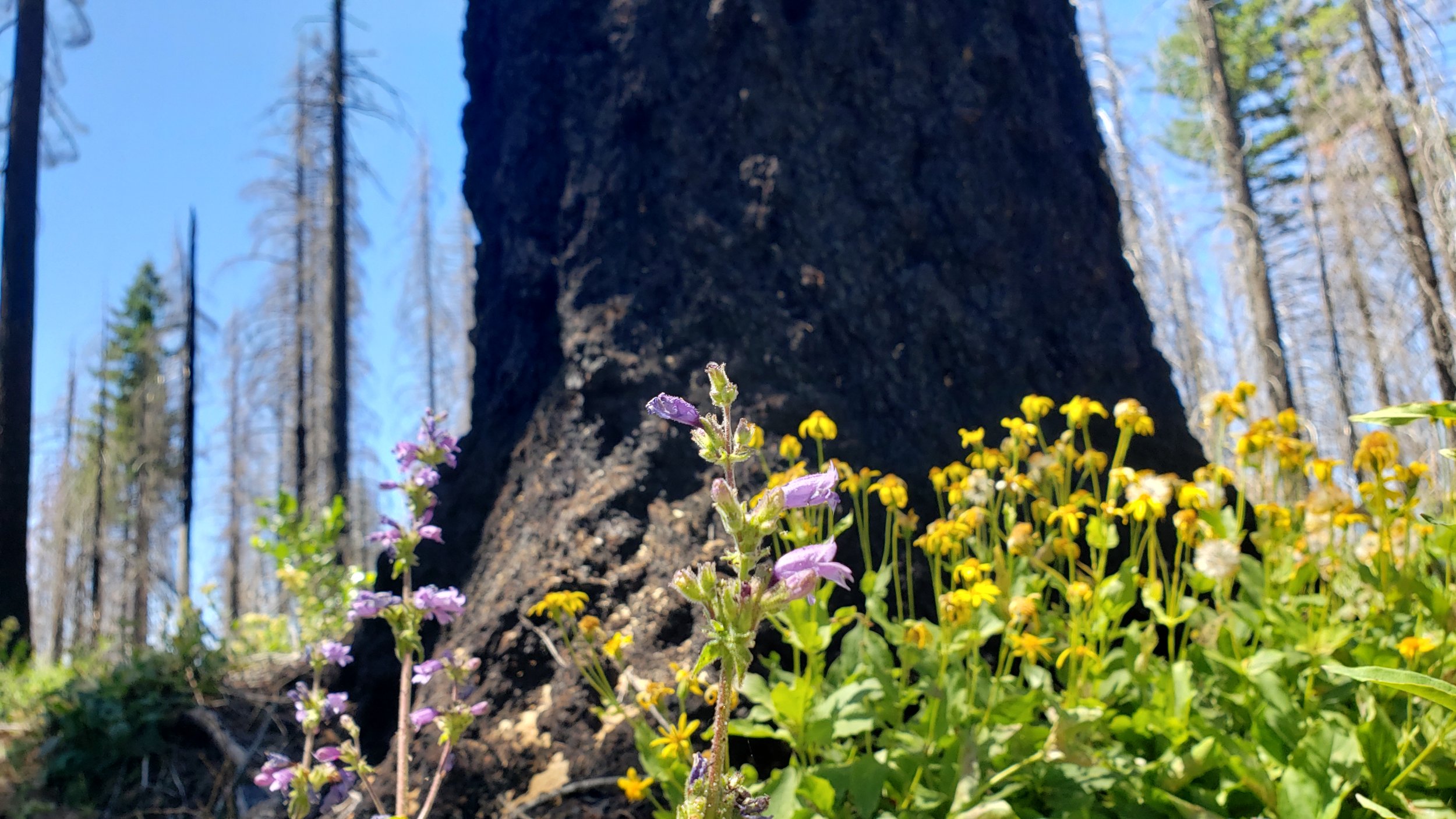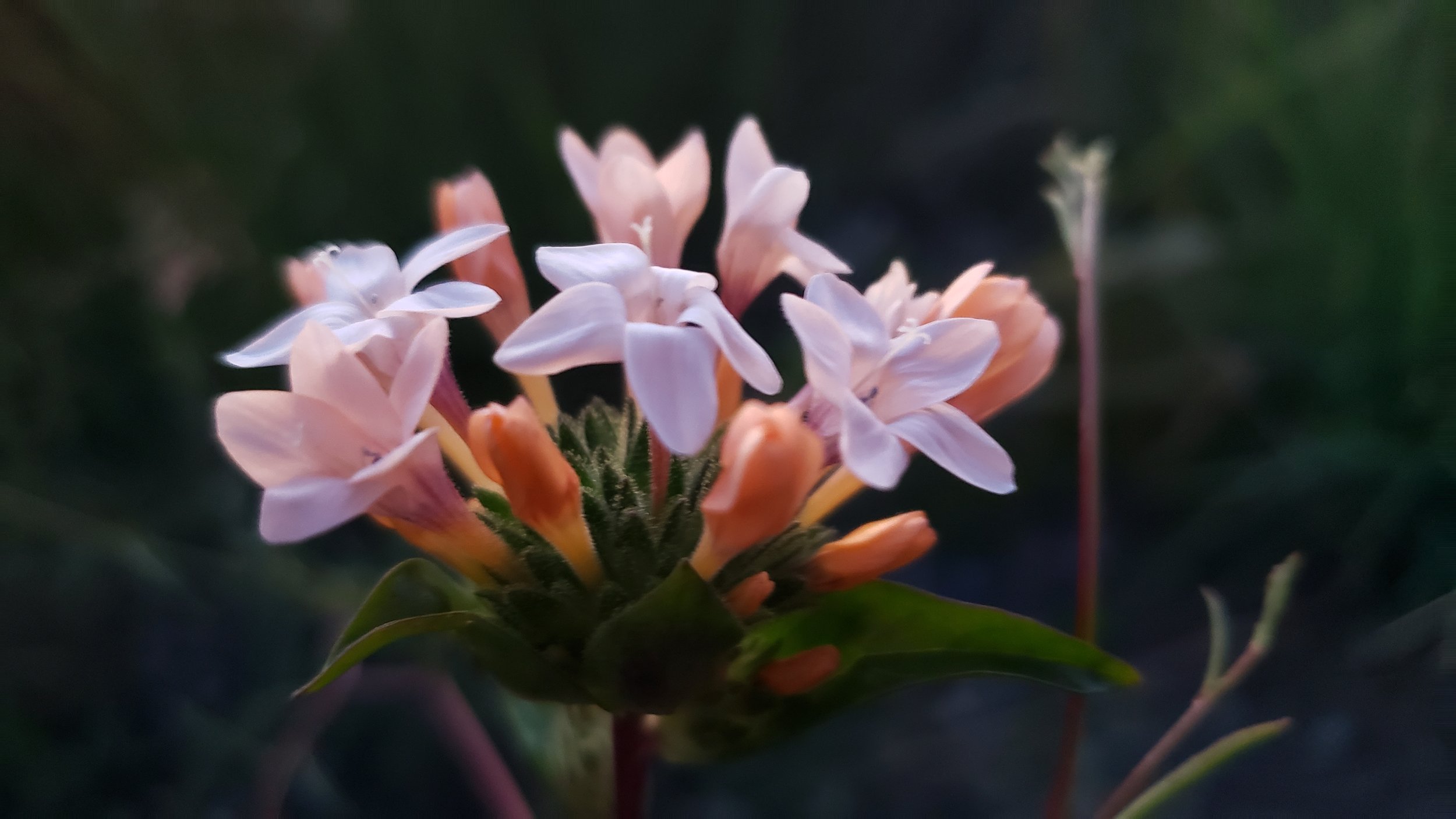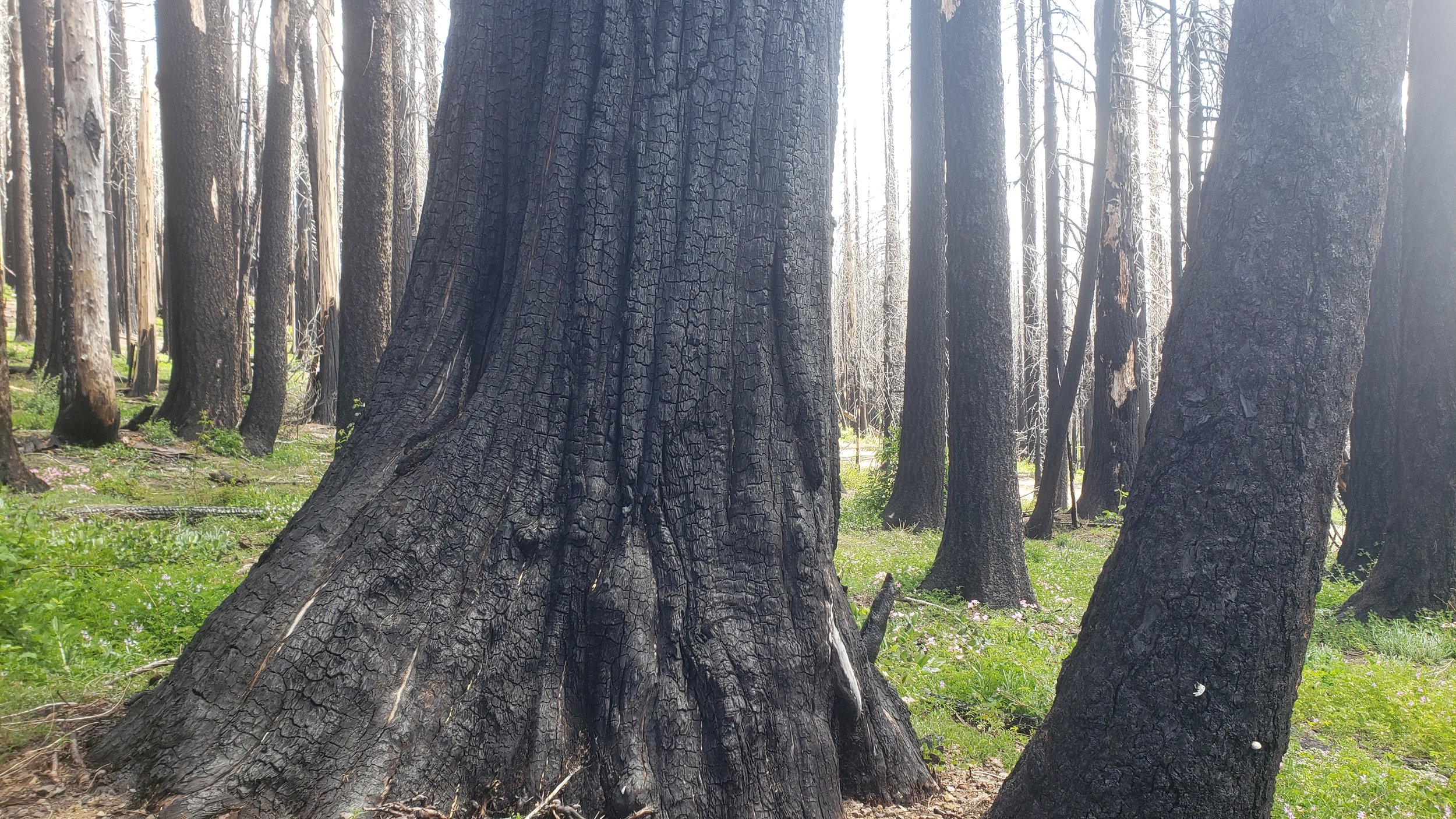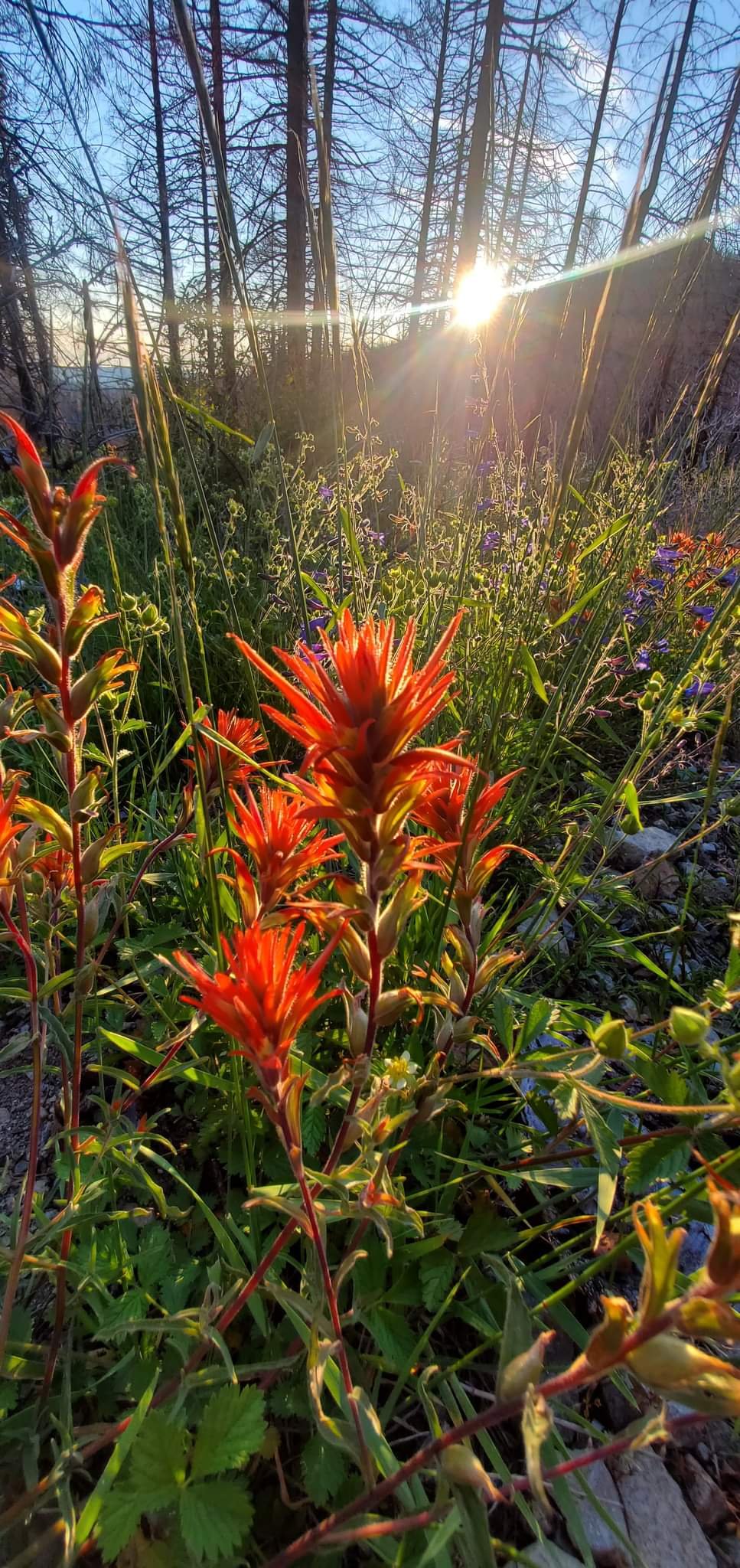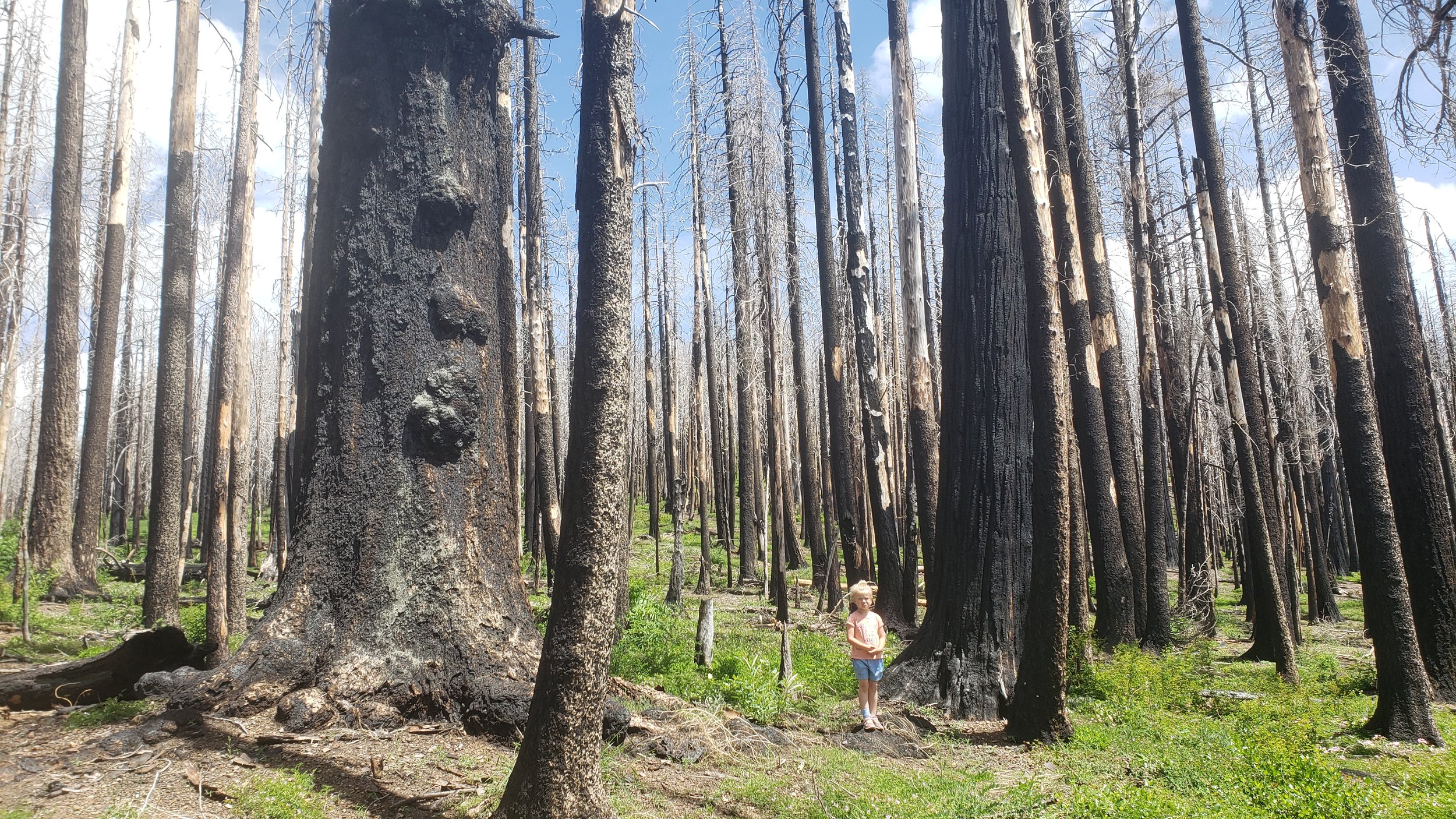Watershed Watch
DCA’s Watershed Watch Program monitors, and takes action to protect against, threats to the health and safety of our natural and human communities in the Deer Creek watershed and beyond.
From antiquated old growth timber sales on public lands in and around our homes and in the last wild places, to aggressive post-fire clearcut logging on public lands in recovering, fragile fire-affected ecosystems, to private corporate land clearcutting and toxic pesticide applications near our homes and water sources, our community is constantly faced with threats from destructive forest management practices. The impacts have local to global significance.
Public Lands Protection
Protecting public lands has been the heart of our work from the very beginning. DCA was formed in the early 1980s by a collection of Selma residents concerned about the erosion of their properties along the banks of Deer Creek and its tributaries due to the clearcut logging happening on Bureau of Land Management (BLM) public lands in the uplands.
Most of our public lands in the Deer Creek watershed are federal lands managed by the BLM. These lands are interspersed between, and directly adjacent to, homes and rural neighborhoods due to the checkerboard nature of the land ownership from the Oregon and California Revested Lands Act of 1937. Many residents rely on nearby public lands as their only source of domestic water, while the cool, moist, fire-resilient ecosystems provide homes with vital wildfire protection.
The value of these public lands is immeasurable. From vast carbon storage and sequestration capacity, to wildlife habitat and connectivity, strongholds for threatened species, incredible genetic diversity, fire resiliency, clean air, and pure, plentiful water, these unique, fire-adapted public lands are an ecological treasure.
Despite the ecological assaults this land has endured over the past few centuries of colonization, the natural resiliency of this unique landscape is truly inspiring. We are fortunate to have beautiful, intact ecosystems that have been spared or saved from logging, as well as many areas that are naturally recovering from past harms. Allowing natural processes to facilitate this natural recovery is a crucial element to the healing of this landscape and the communities who depend on it.
While the national and international importance of protecting these public lands has yet to be fully realized and appreciated, our local community’s safety, sustenance, stability, and survival are intricately connected to these lands.
We continue to advocate for true protection of the ecological processes and species that sustain these ecosystems. Real and lasting protections will require a crucial paradigm shift and redesigning of our human systems and ideologies to be in balance with the natural systems on Earth.
Antiquated Old Growth Public Land Timber Sales
DCA has been working to protect against destructive public land timber sales since the Deer Mom Timber Sale in 1996, which included much of the last remaining lower elevation old growth in the Deer Creek Watershed into one large timber sale. Through grassroots community organizing efforts and ground truthing units for red tree vole nests, the safeguards of Survey and Manage requirements under the Northwest Forest Plan ultimately saved Deer Mom from being logged.
In the 20 years to follow Deer Mom, the BLM continued to include many of those same units in smaller projects and timber sales. Almost every acre of those subsequent projects would eventually be saved from devastation, each campaign a unique story of its own. Decades of hard-fought battles to protect these public lands are a big reason why the Deer Creek watershed still has incredible, healthy, natural ecosystems that are providing countless irreplaceable benefits for humans and all the other species we coexist with.
This incredible old growth ecosystem in the headwaters of the Deer Creek watershed has been saved from numerous timber sales over the years. Photo: Stephen Kirkland
Knowing NEPA
Understanding the National Environmental Policy Act (NEPA) and effectively participating in the process of public lands projects is one of the most important aspects of our Watershed Watch Program. Over the past two and a half decades, DCA’s dedicated volunteers have produced thousands of pages of substantive comments, an extensive library of resources and science that support those comments, and have been an invaluable support for helping affected residents and community members effectively participate in these complex public involvement processes with the agencies.
Ground Truthing
Another important aspect of this protection program is in getting out there to gather data and observations on public lands where managing agencies are proposing projects.
Commonly known as “ground truthing,” this ensures that conditions on the ground are “true” to what is described in the agency’s documents. This is important for identifying and informing the agency of errors or omissions in their assessments and ways that the project is likely to negatively impact the complex and interconnected ecosystems that reside there and the people who depend on these lands for a myriad of values, such as fire-resiliency and domestic water.
Greenwashing Old-Fashioned Timber Sales in the Name of “Resiliency”
Rather than discontinue the controversial and highly unpopular practice of offering mature and old-growth ecosystems for sale in timber sale auctions to logging companies, the BLM has instead become increasingly more sophisticated in greenwashing these timber sales and undermining the NEPA process to streamline them.
In 2016, the BLM replaced the historic Northwest Forest Plan with a new Resource Management Plan (RMP), eliminating important safeguards such as Survey and Manage protocol and the Aquatic Conservation Strategy that had historically provided vital protection for threatened species and watersheds from harmful logging projects on BLM public lands. We are now seeing what the new era of public land management looks like under the new RMP, and it is deeply concerning.
BLM’s IVM Program: A Dangerous New Precedent in Public Land Management
Whether you’ve been tracking this IVM Program from the beginning or just now learning about it, you will likely want to learn more about it and how it may impact you directly in the future. In the Orwellian paradigm where logging is touted as the solution to everything and the only path to so-called “resiliency”, no lands are truly protected. As illustrated in the map below, almost all BLM lands in the Medford District could be impacted by the IVM in the years to come.
What is the IVM?
IVM stands for Integrated Vegetation Management for Resilient Lands
The IVM is a Programmatic Environmental Assessment (EA) that was prepared by the Medford District Bureau of Land Management (BLM).
875,290-acre Planning Area and 684,185-acre Treatment Area across BLM’s Medford District in southern Oregon.
Affects 5 counties: Josephine, Jackson, Coos, Curry, Douglas.
Streamlines approval of controversial timber sales through “programmatic” review.
Now that BLM has approved the programmatic EA, they intend to “tier” project-level timber sales and other forest management activities to the IVM for at least the next 10 years (there is no “sunset date” for the IVM).
Circumvents requirements under the National Environmental Policy Act (NEPA):
Bypasses public involvement and public comment periods.
Inappropriately uses Determinations of NEPA Adequacy (DNA) worksheets, eliminating site-specific environmental assessments and setting a new precedent for the next decade or more of public lands management in southern Oregon.
Authorizes the IVM program for at least 10 years.
The Decision Record approved Alternative C, the most aggressive and dangerous alternative.
Targets Late Successional Reserves (LSRs), Riparian Reserves, and other reserve lands for aggressive commercial logging.
Approves up to 4,000 acres of commercial logging per year/20,000 acres per decade (17,000 within Late Successional Reserves)
The EA has defined “resilience” as canopy reduction down to 30-40% canopy remaining. Canopy cover could be reduced to as low as 30%, disguised as “restoration” and “resiliency” (<29% canopy is considered regeneration harvest/clearcut).
Allows Group Selection Openings (mini-clearcuts) of up to 4 acres in 20% of each stand.
Targets closed-canopy, mid- to late seral ecosystems, which are some of the last remaining mature and ancient ecosystems vital to humans and wildlife.
Approves up to 6,500 acres of small diameter thinning (<1 ft diameter) per year/60,000 acres per decade.
These aggressive, landscape-wide thinning programs are often extremely damaging to the complex, interdependent ecosystems where they are implemented. For example, younger trees that are arbitrarily cut and killed are the future, containing irreplaceable genetics and providing countless ecosystem benefits and services.
While BLM claims “fire resiliency” objectives, this thinning is often done as a sort of pre-commercial thinning for coming back to log the remaining trees in the future. These tree-farming type practices are from the outdated paradigm that we need to shift out of in order to preserve the ecological integrity of Earth’s ecosystems.
Approves up to 7,500 acres of burning per year/70,000 per decade.
A lot of this burning is for pile burning logging slash, or “activity fuel” as BLM calls it. Taxpayers have to foot this huge bill, while local residents are subjected to breathing even more hazardous smoke each year.
The ecological, hydrological, and carbon implications of this landscape-wide thinning and burning program have yet to be analyzed in detail by the agency, the theoretical benefits largely assumed.
Approves up to 10 miles of new “temporary” roads per year/90 miles per decade.
Only trees ≥ 3 feet in diameter and established on or before 1850 would be exempt from harvest. This means the loss of large, fire-resistant trees that are crucial not only for drawing down and keeping carbon in the ground, but for keeping our homes and communities safe from fire.
While BLM is claiming the IVM will keep us safe from fire and increase ecosystem “resilience,” the reality is quite the opposite. The IVM is scientifically unsound, ecologically noncredible, and legally irresponsible. Below are only some of the potential impacts if the IVM is implemented:
Replaces old, fire-resilient trees with young, more flammable species i.e. grasses, shrubs, and saplings.
Creates hotter, dryer, windier conditions and conversion to early seral vegetation, creating higher fire hazards around communities.
Converts natural ecosystems to agricultural “managed” landscapes.
Fragments and degrades crucial habitat for threatened species.
Disrupts and renders dysfunctional natural processes.
Destroys irreplaceable genetic diversity, fungal networks, and natural complexity.
Releases crucial sequestered carbon and drastically reduces photosynthesis and active carbon sequestration by targeting the most carbon-dense areas, removing large powerhouse trees, and landscape-wide removal of vegetation.
Degrades water quality and quantity, causing harm to fish and humans.
Causes irreversible harm to the amenity-based economy and local economic stability.
Taxpayers will be responsible for the huge, externalized costs of “cleaning up” after the timber industry.
Read this study by Bradley et al 2016: Does increased forest protection correspond to higher fire severity in frequent‐fire forests of the western United States? - Bradley - 2016 - Ecosphere - Wiley Online Library
“We found forests with higher levels of protection had lower severity values even though they are generally identified as having the highest overall levels of biomass and fuel loading. Our results suggest a need to reconsider current overly simplistic assumptions about the relationship between forest protection and fire severity in fire management and policy.”
DCA has been heavily involved in this IVM planning process since the beginning in 2019, submitting over 400 pages of substantive, scientifically and legally valid comments, along with hundreds of studies and references over the course of multiple public comment periods. We attended in person and virtual open houses, corresponded regularly with agency staff with questions and concerns, coordinated a powerful public outreach campaign with the help of our dedicated volunteers, and worked closely networking with our allies across southwestern Oregon and regionally through the Pacific Northwest Forest Climate Alliance.
IVM Timeline
IVM Scoping notice released July 4, 2019
IVM Draft Environmental Assessment (EA) Chapters 1 & 2 released October 29, 2019
IVM Programmatic EA and Draft Finding of No Significant Impact (FONSI) released August 17, 2020
IVM Biological Assessment & Biological Opinion released on February 8, 2022
IVM Programmatic Decision Record & Final FONSI released March 2, 2022
Late Mungers IVM Project Draft Determination of NEPA Adequacy (DNA) released April 28, 2022
Late Mungers IVM Project Decision and Final DNA released February 10, 2023
Late Mungers and Penn Butte Timber Sale Auction scheduled for September 2023 - POSTPONED
BLM’s IVM Website: Maps, Documents, Updates
Navigating BLM’s “New” NEPA Process
Under the IVM, the NEPA process as we have always known it is no more. There will no longer be a “Scoping” comment period and then a site-specific Environmental Assessment (EA) with another public comment period before BLM issues a final “decision” on the project. Instead, BLM intends to plan, design, and even mark trees in timber sale units, before informing the public of any preliminary project proposal. The elimination of public scoping is significant (and likely illegal) as scoping has always been a foundational pillar of the NEPA process.
Given the secrecy with which they planned, and even marked, the units for the Late Mungers and Penn Butte timber sales before any public involvement, it is expected this same type of planning will be the norm for timber sales under the IVM on future projects as well. We believe that logging Late Successional Reserves in particular should have more public involvement, not less, as these are the lands most treasured by the public and most ecologically intact. This streamlining of the NEPA process, if the IVM is not stopped, could lead to devastating impacts to our public lands for the indefinite future.
After BLM has already invested a massive amount of taxpayer dollars into designing their logging project, then the public will likely have one public comment period to respond to BLM’s Determination of NEPA Adequacy (DNA) worksheet. Gathering public input so late in the planning process makes it less likely that BLM will be able to incorporate this input or adjust the project to avoid significant adverse impacts to the public. This is why scoping is such a crucial part of the NEPA process and why eliminating scoping is so egregious.
The length of the single DNA comment period could vary depending on the project and the public interest. The standard comment period for commercial timber sales is likely to be 30 days, but perhaps could be less or none at all for “noncommercial” projects, or the BLM may choose to extend the comment deadline for certain projects based on public requests. Nevertheless, 30 days is an extremely short window for the public to be able to read BLM’s complex documents, find the project units on the landscape, and write substantive comments to the agency. Many residents who may be directly impacted by a project may not even learn about the opportunity to comment.
After reviewing public comments, or possibly without any opportunity for public comment for some projects, BLM would issue a Final DNA with their Decision Record. At that point, there would usually be an opportunity for those who previously commented on the project to file an “Appeal” to the Interior Board of Land Appeals (IBLA) within 30 days of the Decision.
Note: In 2021 the BLM’s Final Rule went into effect which eliminated the opportunity to submit Administrative Protests in response to Decisions, making it even more difficult for the public to participate in public lands projects. Now when Decisions come out, the public’s only administrative remedy is to file an appeal to the Interior Board of Land Appeals, which is a far more technical and complicated process.
The review of an appeal by IBLA could potentially take years, and without a “stay” or legal injunction on the project, the whole project could be auctioned off and logged before the IBLA has even ruled on the merits of an appeal. Given the unlikelihood of IBLA ruling against the BLM and the project being stopped through the appeal process, costly and time-consuming litigation may be the only real option for public recourse. The likely increase in litigation will lead to an unfortunate and avoidable waste of taxpayer money.
The IVM’s reduction in transparency and circumvention of NEPA has essentially shut the public out of public land management. Abandoning this “new,” streamlined approach to NEPA is in the best interest of our public land management agencies and the public in which they are hired to serve.
BLM plans first Late Successional Reserve timber sales under the controversial IVM:
Penn Butte and Late Mungers Timber Sales Threaten Mungers Wildlands
Mungers Wildlands, the mountains that separate the Deer Creek, Williams Creek, and Murphy Creek watersheds, are the target of BLM’s next big timber sales.
From the ridge near Mungers Butte that connects the Deer Creek and Williams Creek watersheds. Youth looking east over the Williams Creek watershed and Applegate Valley. Photo: Photo Synthesis Rising
Even before the IVM Programmatic Environmental Assessment (EA) was prepared to assess whether this program of work would cause significant impacts, as required by the National Environmental Policy Act (NEPA), the BLM has been planning the “Late Mungers Integrated Vegetation Management Project,” which BLM has “tiered” to the IVM Programmatic EA. This inappropriate use of “tiering” is one of the ways that BLM has circumvented the NEPA process.
In 2019, BLM released a draft scoping map of the Late Mungers Project Area that included almost the entire 85,000+ acre “Northern Spotted Owl Large Block Late Successional Reserve” that spans the wildlands between Selma, Williams, and Murphy. This incredible, beautifully biodiverse area is locally referred to as Mungers Wildlands.
Map showing the Land Use Allocations under the 2016 Resource Management Plan (RMP). View the interactive map here.
Many of our homes and properties in Selma, Williams, and Murphy are directly bordering or near the Large Block LSR included in the Late Mungers Project Area. We depend on these already highly resilient lands for our domestic water, protecting our homes from fire, recreation and quality of life, property values, carbon storage and sequestration capacity, habitat and connectivity for a diversity of species, the survival of threatened species, irreplaceable ancient genetics, and all the natural processes and species that sustain the ecosystems we live within.
If you are wondering what public lands are near you and what the Land Use Allocations are on your public lands under the 2016 Resource Management Plan, visit BLM’s Interactive Map.
Instead of planning Late Mungers under the traditional NEPA process as BLM had originally planned, they instead waited for the IVM Programmatic EA to be authorized in order to streamline implementation of the Late Mungers Project under the IVM.
The Late Mungers Timber Sale & Penn Butte Timber Sale are the first site-specific timber sales being developed under the IVM. These first timber sales are primarily located in the Williams Creek and Murphy Creek watersheds and some in the upper Deer Creek watershed. However, BLM has expressed that the Deer Creek half of the project area could be part of “Phase 2” of Late Mungers.
The Draft DNA for Late Mungers was released on April 28, 2022 with a 30-day public comment period that BLM extended an additional 30 days. BLM originally expected to auction off these timber sales in the fall of 2022. However, likely due to the overwhelming public response, the auction was postponed and the Final DNA and Decision Record were not released until February 10, 2023. The timber sale auction that was rescheduled for the fall of 2023 has now again been postponed.
There are two timber sales being packaged for auction under the Late Mungers IVM Project: the Penn Butte and Late Mungers Timber Sales. The Penn Butte timber sale is expected to auction 6.595 million board feet of timber (over 1,300 log trucks) from 491 acres in Late Successional Reserves in the Marble Gulch and Upper Powell Creek in the Williams Watershed, two of Williams’ most pristine areas for recreation and water supply. The Late Mungers Timber Sale is expected to auction 2.5 million board feet of timber from 312 acres of Late Successional Reserves. If not stopped, Late Mungers could be just the tip of the iceberg for BLM’s logging plans for southern Oregon over the next decade+.
Learn more about the timber sale units: BLM Targets Mungers & Powell Creek, the Rain Forests of the Applegate, with Logging in the Penn Butte Timber Sale – Applegate Siskiyou Alliance
A delicate Calypso Orchid blooming in the Penn Butte Timber Sale Unit 25-2 off Upper Powell Creek Rd near the community of Williams. Photo: Photo Synthesis Rising
The IVM’s circumvention of site-specific environmental analysis and public involvement requirements under NEPA is unprecedented and egregious. The IVM is targeting Late Successional Reserve lands for heavy industrial logging in the name of fire resiliency and protecting threatened species, when their so-called “treatments” will do the exact opposite, increasing fire hazards and degrading and removing important habitat for threatened species. It is imperative to stop the Late Mungers IVM Project and the heavily flawed and biased IVM Programmatic Environmental Assessment it is “tiered” to.
BLM’s Late Mungers IVM Project Website
Current Status & What’s Next
BLM received an overwhelming public response to their controversial IVM program of work, with over 1,000 public comments submitted during the EA comment period and hundreds more throughout the whole process.
DCA has worked hard to participate every step of the way since the IVM was released more than 4 years ago. We have done our best to navigate the complex appeal process and put together two in-depth, thorough appeals to the Interior Board of Land Appeals to represent the concerns of our members and supporters and to defend the health of our wildlands, watersheds, and communities in Southern Oregon from the Medford District BLM’s dangerous IVM program and Late Mungers IVM Project.
The Late Mungers IVM Project confirmed that the IVM program is simply a tool to expedite the logging of our last remaining ancient ecosystems in Late Successional Reserves under the guise of “resiliency” and “restoration.” The Late Mungers and Penn Butte timber sales could be only the beginning of the destruction if the IVM program is not stopped.
Please consider donating to support DCA’s public lands protection work.
Post-Fire Logging
Post-fire logging is both a public and private land issue. While there is unfortunately little ability for the general public to prevent private land logging after a fire, logging projects on public lands are supposed to undergo a rigorous environmental assessment process under NEPA to adequately assess and disclose to the public the environmental impacts of a proposed project and determine if those impacts meet the criteria for “significance” under NEPA.
Unfortunately, what is commonly referred to as “salvage” logging is usually treated differently and streamlined compared to other green tree logging projects, despite the more fragile burned soils, displaced wildlife, and sensitivity of watersheds following a fire. It’s also important to note that a significant amount of logging occurs during wildfires. This type of logging is done with no public involvement, oversight, or analysis of impacts. For example, the photos below show what kind of logging can happen before a fire has been officially declared “contained.”
2020 Slater Fire logging along Happy Camp Rd. in the Siskiyou Mountains. Photo: Deer Creek Photography
Decked old growth logs from 2020 Slater Fire logging along Happy Camp Rd. near Takilma, OR. Photo: USFS
While the mixed-severity wildfire that burns in natural mosaics across the landscape can be a remarkable rebirth of the land and produce unparalleled biodiversity, these potential benefits are lost when post-fire logging occurs, irreplaceably interrupting the incredibly complex natural regeneration processes these lands and species have developed from their beginning.
Beauty in the Burn
Looking up the East Fork Illinois River watershed towards the magnificent Siskiyou Mountains. This photo of beautiful burn mosaics was taken a few months after the 2020 Slater Fire was put out by the fall rains. Photo: Deer Creek Photography
Fire is an extremely complex issue, and one that brings up a lot of deep emotions for many. Our human communities are struggling to become fire-resilient in the midst of pervasive misinformation and false solutions. Appreciating the beauty in the burn may be difficult for some. However, our natural communities have lived with fire from their beginning and have evolved incredible adaptations to survive and recover from wildlife, even high severity wildfire. Some species even need high severity wildfire to survive. In the summer of 2022, the Slater Fire footprint experienced an incredible “super bloom” event that particularly highlighted the beauty in the burn when allowed to naturally regenerate.
Learn more about the Slater Fire Super Bloom & Fire Effects – The Siskiyou Crest
2021 Slater Re-entry Project
After the wildfire season of 2020, we saw massive roadside post-fire logging projects get introduced all across public lands in the west. In our local Siskiyou Mountains where the Slater Fire burned in the Rogue-River-Siskiyou National Forest, the US Forest Service attempted to implement up to 146 miles of roadside clearcuts on 200 ft on either side of the roads with the inappropriate use of a categorical exclusion. The first iteration of this project was called the “Slater Fire Safe Re-entry Project.”
Most of the over 4,000 acres in the Slater Re-entry Project were not logged due to legal action and a settlement agreement between the Forest Service, Klamath Forest Alliance, and Crag Law Center. Read more about the Victory in the Slater Fire Footprint: KFA and Crag Law Center protect fragile post-fire forests on the Siskiyou Crest – The Siskiyou Crest
Below are before and after photos of the roadside logging implemented on road 4804, an unpaved spur road off of Happy Camp Road where the Slater Re-entry Project was unfortunately implemented.
Before Slater Reentry Post-Fire Logging
After Slater Reentry Post-Fire Logging
US Forest Service reintroduces the Slater Re-entry Project in 2022 under a new name
Unfortunately, the devastation on Happy Camp Road and Road 4804 is what the US Forest Service (USFS) plans to implement on almost all the roads in the Slater Fire footprint under a new project name. In the summer of 2022, the Forest Service chose to essentially reintroduce the Slater Re-entry Project on an even larger project area as the “Slater Fire Road System Risk Reduction and Safety Project.” This time, the USFS conducted the appropriate NEPA analysis in an Environmental Assessment, which was released in April 2023.
The areas that were saved from the Slater Re-entry Project are now again on the chopping block. USFS released a Final Decision and Finding of No Significant Impact (FONSI) on October 5, 2023.
Release of the Final Decision means that implementation of this destructive project could begin immediately.
What’s At Stake?
Roadside Areas in the Slater Fire Footprint Currently Threatened with Clearcutting
Our Watershed Watch Program has been, and will continue to, network with our allies and monitor these post-fire logging projects that threaten the beauty and biodiversity of our beloved Siskiyou Mountains. Please contact us if you feel inclined to join this effort and please consider donating to support this important work.
Dive deeper into the “hot” topics around wildfire and management in our Fire & “Fuels” Library
Corporate Clearcutting & Chemicals
While public lands have requirements and procedures in place to help protect them and the public from the impacts of management, privately owned timber lands have far fewer requirements and procedures that protect the ecosystems and local residents from harm. While the legal requirements on public lands can be successfully upheld in court, if necessary, there is very little recourse, or ability to seek protection, under the law from the harms caused by private timber land practices.
Corporate clearcutting, and the accompanying chemical applications, has been an ongoing threat for our local community for many decades. However, more recently, the lands that were originally owned and managed by local or regional companies were bundled and sold to multi-national investment corporations such as John Hancock Life Insurance Company. The sheer pace and scale of this new era of investment corporation logging is rapidly destroying one of the most unique and biodiverse areas on the planet. Entire mountaintops, watersheds, and beautiful, healthy ecosystems are being rapidly liquidated to produce a return on wealthy shareholders’ investments.
The once-natural ecosystems that existed on these destroyed lands are subsequently converted into dense, sterile, tree farms. Part of these tree farming practices involves numerous applications of dangerous chemicals to kill the natural regenerating vegetation that is viewed as competition for their newly planted tree crop.
Between the loss of water, chemical pollution of the water and soil, habitat loss and fragmentation, the release of carbon and loss of sequestration capacity, the huge increase in fire hazard conditions near our homes and communities, ugly scars that detract from our local tourism economy and property values, and assault on our quality of life, these aggressive industrial logging practices are hugely damaging to our frontline communities.
You can subscribe to receive email notifications with the Oregon Department of Forestry (ODF) regarding pesticide applications, harvesting activities, road building, and other permitted activities through FERNS (Forest Activity Electronic Reporting and Notification System). You can subscribe to a specific geographic area, whether you want to be alerted to activities next door, down the street, in your town, watershed, county, or statewide.
If you are passionate about this issue and would like to work on finding short and long-term solutions to this urgent problem, please connect with us and consider joining our Watershed Watch Program!
Join Watershed Watch
There are many aspects to DCA’s Watershed Watch program, from writing comments on agency documents, to ground truthing timber sale units, educating and engaging the public in knowing what is at stake and how they can make a difference, and much more.
There is amazing potential for exponential growth of this important program depending on the unique strengths, passions, and availability of our team members. You name a skill, and likely there is a niche for it in our program. If defending the unique ecosystems in southwestern Oregon interests you, please reach out and connect with us!
Our Place
Discover why the Deer Creek watershed is so special and why we work so hard to protect this ‘deer’ place.
Arts In The Wild
Connect with this uniquely wild landscape through the magic & mystery of the arts!



